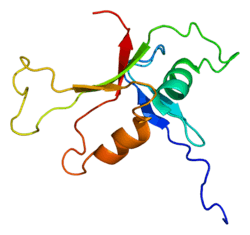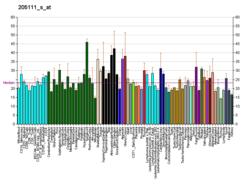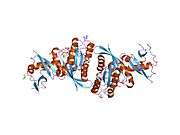PLCE1
1-Phosphatidylinositol-4,5-bisphosphate phosphodiesterase epsilon-1 (PLCE1) is an enzyme that in humans is encoded by the PLCE1 gene.[5][6] This gene encodes a phospholipase enzyme (PLCE1) that catalyzes the hydrolysis of phosphatidylinositol-4,5-bisphosphate to generate two second messengers: inositol 1,4,5-triphosphate (IP3) and diacylglycerol (DAG). Mutations in this gene cause early-onset nephrotic syndrome and have been associated with respiratory chain deficiency with diffuse mesangial sclerosis.[7][8]
Structure
PLCE1 is located on the q arm of chromosome 10 in position 23.33 and has 39 exons.[7] PLCE1, the protein encoded by this gene, is located on the Golgi apparatus, the cell membrane, and in the cytosol. It contains 3 turns, 15 beta strands, and 6 alpha helixes. PLCE1 contains a 260 amino acid Ras-GEF domain at p. 531-790, a 149 amino acid PI-PLC X-box domain at p. 1392-1540, a 117 amino acid PI-PLC Y-box domain at p. 1730 – 1846, a 101 amino acid C2 domain at p. 1856 – 1956, a 103 amino acid Ras-associating 1 domain at p. 2012 – 2114, and a 104 amino acid Ras-associating 2 domain at p. 2135 – 2238. There is a region of 79 amino acids from p. 1686 – 1764 that is required for PLCE1 to be activated by RHOA, RHOB, GNA12, GNA13 and G-beta gamma. PLCE1 also has a Ca2+ cofactor.[6][9][10] Alternative splicing results in multiple transcript variants encoding distinct isoforms.[7]
Function
PLCE1 belongs to the phospholipase family that catalyzes the hydrolysis of polyphosphoinositides such as phosphatidylinositol-4,5-bisphosphate (PtdIns(4,5)P2) to generate the second messengers Ins(1,4,5)P3 and diacylglycerol. These products initiate a cascade of intracellular responses that result in cell growth and differentiation and gene expression.[supplied by OMIM][7]
Clinical significance
Mutations in this gene cause early-onset nephrotic syndrome. This disease is characterized by proteinuria, edema, and diffuse mesangial sclerosis or focal and segmental glomerulosclerosis.[7] Signs and symptoms include kidney biopsies demonstrating non-specific histologic changes such as focal segmental glomerulosclerosis and diffuse mesangial proliferation as well as genetic tests revealing a pathogenic S1484L mutation. Diffuse mesangial proliferation is characterized by mesangial matrix expansion with no mesangial hypercellularity, hypertrophy of the podocytes, vacuolized podocytes, thickened basement membranes, and diminished patency of the capillary lumen.[11][9][10] This disease has also been associated with mitochondrial cytopathy stemming from respiratory chain deficiency primarily affecting complex IV.[8]
Additionally, Phospholipase C epsilon modulates beta-adrenergic receptor-dependent cardiac contraction and it has been found that this protein is over expressed during heart failure. Research has suggested that PLCE1 may thus inhibit cardiac hypertrophy.[12][9][10]
Interactions
PLCE1 has been shown to have 12 binary protein-protein interactions including 8 co-complex interactions. PLCE1 appears to interact with RyR2, HRAS, NRAS, and LIMS1.[13]
References
- GRCh38: Ensembl release 89: ENSG00000138193 - Ensembl, May 2017
- GRCm38: Ensembl release 89: ENSMUSG00000024998 - Ensembl, May 2017
- "Human PubMed Reference:". National Center for Biotechnology Information, U.S. National Library of Medicine.
- "Mouse PubMed Reference:". National Center for Biotechnology Information, U.S. National Library of Medicine.
- Lopez I, Mak EC, Ding J, Hamm HE, Lomasney JW (January 2001). "A novel bifunctional phospholipase c that is regulated by Galpha 12 and stimulates the Ras/mitogen-activated protein kinase pathway". The Journal of Biological Chemistry. 276 (4): 2758–65. doi:10.1074/jbc.M008119200. PMID 11022047.
- Song C, Hu CD, Masago M, Kariyai K, Yamawaki-Kataoka Y, Shibatohge M, Wu D, Satoh T, Kataoka T (January 2001). "Regulation of a novel human phospholipase C, PLCepsilon, through membrane targeting by Ras". The Journal of Biological Chemistry. 276 (4): 2752–7. doi:10.1074/jbc.M008324200. PMID 11022048.
- "Entrez Gene: PLCE1 phospholipase C, epsilon 1".

- Baskin E, Selda Bayrakci U, Alehan F, Ozdemir H, Oner A, Horvath R, Vega-Warner V, Hildebrandt F, Ozaltin F (July 2011). "Respiratory-chain deficiency presenting as diffuse mesangial sclerosis with NPHS3 mutation". Pediatric Nephrology. 26 (7): 1157–61. doi:10.1007/s00467-011-1814-0. PMC 3329966. PMID 21365190.
- "PLCE1 - 1-phosphatidylinositol 4,5-bisphosphate phosphodiesterase epsilon-1 - Homo sapiens (Human) - PLCE1 gene & protein". www.uniprot.org. Retrieved 2018-08-30.

- "UniProt: the universal protein knowledgebase". Nucleic Acids Research. 45 (D1): D158–D169. January 2017. doi:10.1093/nar/gkw1099. PMC 5210571. PMID 27899622.
- Hinkes B, Wiggins RC, Gbadegesin R, Vlangos CN, Seelow D, Nürnberg G, et al. (December 2006). "Positional cloning uncovers mutations in PLCE1 responsible for a nephrotic syndrome variant that may be reversible". Nature Genetics. 38 (12): 1397–405. doi:10.1038/ng1918. PMID 17086182.
- Wang H, Oestreich EA, Maekawa N, Bullard TA, Vikstrom KL, Dirksen RT, Kelley GG, Blaxall BC, Smrcka AV (December 2005). "Phospholipase C epsilon modulates beta-adrenergic receptor-dependent cardiac contraction and inhibits cardiac hypertrophy". Circulation Research. 97 (12): 1305–13. doi:10.1161/01.RES.0000196578.15385.bb. PMID 16293787.
- IntAct. www.ebi.ac.uk https://www.ebi.ac.uk/intact/interactions?conversationContext=1. Retrieved 2018-08-30. Missing or empty
|title=(help)
Further reading
- Jefferson JA, Shankland SJ (July 2007). "Familial nephrotic syndrome: PLCE1 enters the fray". Nephrology, Dialysis, Transplantation. 22 (7): 1849–52. doi:10.1093/ndt/gfm098. PMID 17449496.
- Cefai D, Debre P, Kaczorek M, Idziorek T, Autran B, Bismuth G (December 1990). "Human immunodeficiency virus-1 glycoproteins gp120 and gp160 specifically inhibit the CD3/T cell-antigen receptor phosphoinositide transduction pathway". The Journal of Clinical Investigation. 86 (6): 2117–24. doi:10.1172/JCI114950. PMC 329852. PMID 1979339.
- Zauli G, Previati M, Caramelli E, Bassini A, Falcieri E, Gibellini D, Bertolaso L, Bosco D, Robuffo I, Capitani S (September 1995). "Exogenous human immunodeficiency virus type-1 Tat protein selectively stimulates a phosphatidylinositol-specific phospholipase C nuclear pathway in the Jurkat T cell line". European Journal of Immunology. 25 (9): 2695–700. doi:10.1002/eji.1830250944. PMID 7589147.
- Chen P, Mayne M, Power C, Nath A (September 1997). "The Tat protein of HIV-1 induces tumor necrosis factor-alpha production. Implications for HIV-1-associated neurological diseases". The Journal of Biological Chemistry. 272 (36): 22385–8. doi:10.1074/jbc.272.36.22385. PMID 9278385.
- Mayne M, Bratanich AC, Chen P, Rana F, Nath A, Power C (1998). "HIV-1 tat molecular diversity and induction of TNF-alpha: implications for HIV-induced neurological disease". Neuroimmunomodulation. 5 (3–4): 184–92. doi:10.1159/000026336. PMID 9730685.
- Haughey NJ, Holden CP, Nath A, Geiger JD (October 1999). "Involvement of inositol 1,4,5-trisphosphate-regulated stores of intracellular calcium in calcium dysregulation and neuron cell death caused by HIV-1 protein tat". Journal of Neurochemistry. 73 (4): 1363–74. doi:10.1046/j.1471-4159.1999.0731363.x. PMID 10501179.
- Nagase T, Kikuno R, Ishikawa K, Hirosawa M, Ohara O (April 2000). "Prediction of the coding sequences of unidentified human genes. XVII. The complete sequences of 100 new cDNA clones from brain which code for large proteins in vitro". DNA Research. 7 (2): 143–50. doi:10.1093/dnares/7.2.143. PMID 10819331.
- Mayne M, Holden CP, Nath A, Geiger JD (June 2000). "Release of calcium from inositol 1,4,5-trisphosphate receptor-regulated stores by HIV-1 Tat regulates TNF-alpha production in human macrophages". Journal of Immunology. 164 (12): 6538–42. doi:10.4049/jimmunol.164.12.6538. PMID 10843712.
- Jin TG, Satoh T, Liao Y, Song C, Gao X, Kariya K, Hu CD, Kataoka T (August 2001). "Role of the CDC25 homology domain of phospholipase Cepsilon in amplification of Rap1-dependent signaling". The Journal of Biological Chemistry. 276 (32): 30301–7. doi:10.1074/jbc.M103530200. PMID 11395506.
- Schmidt M, Evellin S, Weernink PA, von Dorp F, Rehmann H, Lomasney JW, Jakobs KH (November 2001). "A new phospholipase-C-calcium signalling pathway mediated by cyclic AMP and a Rap GTPase". Nature Cell Biology. 3 (11): 1020–4. doi:10.1038/ncb1101-1020. PMID 11715024.
- Evellin S, Nolte J, Tysack K, vom Dorp F, Thiel M, Weernink PA, Jakobs KH, Webb EJ, Lomasney JW, Schmidt M (May 2002). "Stimulation of phospholipase C-epsilon by the M3 muscarinic acetylcholine receptor mediated by cyclic AMP and the GTPase Rap2B". The Journal of Biological Chemistry. 277 (19): 16805–13. doi:10.1074/jbc.M112024200. PMID 11877431.
- Song C, Satoh T, Edamatsu H, Wu D, Tadano M, Gao X, Kataoka T (November 2002). "Differential roles of Ras and Rap1 in growth factor-dependent activation of phospholipase C epsilon". Oncogene. 21 (53): 8105–13. doi:10.1038/sj.onc.1206003. PMID 12444546.
- Bennasser Y, Badou A, Tkaczuk J, Bahraoui E (November 2002). "Signaling pathways triggered by HIV-1 Tat in human monocytes to induce TNF-alpha". Virology. 303 (1): 174–80. doi:10.1006/viro.2002.1676. PMID 12482669.
- Czyzyk J, Brogdon JL, Badou A, Henegariu O, Preston Hurlburt P, Flavell R, Bottomly K (May 2003). "Activation of CD4 T cells by Raf-independent effectors of Ras". Proceedings of the National Academy of Sciences of the United States of America. 100 (10): 6003–8. Bibcode:2003PNAS..100.6003C. doi:10.1073/pnas.1031494100. PMC 156316. PMID 12721365.
- Lennartsson J, Wernstedt C, Engström U, Hellman U, Rönnstrand L (August 2003). "Identification of Tyr900 in the kinase domain of c-Kit as a Src-dependent phosphorylation site mediating interaction with c-Crk". Experimental Cell Research. 288 (1): 110–8. doi:10.1016/S0014-4827(03)00206-4. PMID 12878163.
- vom Dorp F, Sari AY, Sanders H, Keiper M, Oude Weernink PA, Jakobs KH, Schmidt M (August 2004). "Inhibition of phospholipase C-epsilon by Gi-coupled receptors". Cellular Signalling. 16 (8): 921–8. doi:10.1016/j.cellsig.2004.01.009. PMID 15157671.
This article incorporates text from the United States National Library of Medicine, which is in the public domain.









